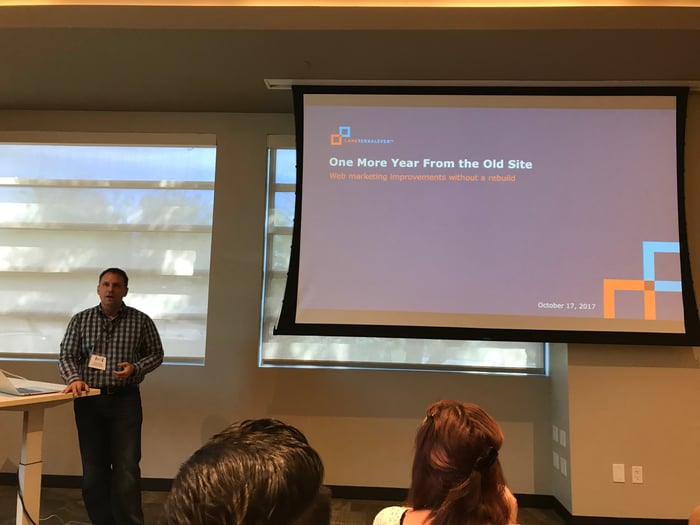A website rebuild is expensive (sometimes upwards of six figures), often takes a long time, and requires many people. For most companies, a website redesign or build needs a massive executive buy-in and, quite frankly, it’s a pain to do.
LaneTerralever’s Chief Operating Officer Dave Foster understands the inconvenient realities that come with a new website. At a recent Arizona Technology Council event, he discussed four website optimizations that can help extend the life of your website, delaying the inevitable rebuild a bit longer.
Any or all of the following four tactics for your web marketing can help: limit your costs severely, utilize simple services, focus on leveraging existing content, and minimize additional IT needs.
How to optimize your website with four easy tactics.
Hosted landing pages
Leverage proven tools (like unbounce) to build one-page landing pages that can capture information from customers. The capabilities of current tools allow you to create or utilize an existing page template that looks like it’s a part of your website, even if it’s really not.
How this helps you: This option is more cost-effective than connecting to your main website. You can track customer behavioral data, implement digital media campaigns, and send outbound emails. Overall, it’ll make your site feel like you have a lot more going on. “You can spin up a couple landing pages and send out targeted ads basically overnight, which is something most companies can’t do with their main websites,” Foster explained.
Cost: Modest
ADA compliance
There are more and more lawsuits popping up across the country involving websites being ADA-compliant (6,601 in 2016). The first strategy in meeting ADA compliance is to know where your website stands using a tool like Siteimprove.
How this helps you: Partnering with a tool like Siteimprove will allow your website to be scanned on a regular basis; you’ll then receive feedback on a variety of dimensions, not just ADA compliance, that include a grade and areas of improvement. Suggested changes should be reviewed for cost, and high-impact, low-effort ones pursued. Keep in mind, ignorance of ADA compliance is not a reasonable excuse that any court will accept. Go after easy-to-fix improvements that show you’re making a steady progress until you’re able to invest in a site rebuild. For more info on ADA compliance fixes you can make, check out our blog.
Cost: Modest
Conversion optimization
Take a quick audit of high-performing pages and create a list of ideal conversion paths. Look at when your customers are arriving at the website, making a purchase, or submitting a form and find a way to boost and improve that path. Reconsider key images used and be sure to inspect your analytics prior to making any changes.
How this helps you: Targeting a few specific items on your site can be a low-cost, minimally invasive change that gives you the “oomph” you need prior to being able to redo the whole site. While this option can take a little extra brainpower from your staff, it won’t hit the wallet as hard.
Cost: Inexpensive
Mobile access
Google is going mobile-first; so should your website. Plan to take an assessment of your site’s mobile experience and look for minor tweaks that can be made to make it more mobile-friendly. One example of this is creating “AMP” pages. To control costs, keep AMP pages very basic and only plan to create 5-10 key pages for a medium-sized site.
How this helps you: As you create simple parallel parallel pages for your high-traffic/high-value pages, you’re likely to see Google boost the speed and prominence of the page in search results for mobile. There’s also a presumed secondary benefit to SEO, since you're likely to have a reduced abandon rate.
Cost: Medium
Do you have an easy website optimization not mentioned above? Tell us about it in the comments below. If you’d like help with any of these fixes or are ready for a website rebuild, fill out the form below to see how our team can help!




